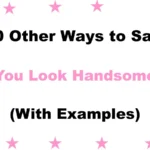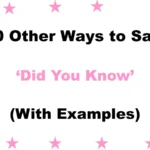Finding the right words to show support and encouragement can truly make a difference. Whether you’re cheering on a colleague, sending off a friend, or closing a professional email, choosing something more thoughtful than just “good luck” helps your message feel more personal and meaningful.
These alternatives carry warmth, sincerity, and professionalism, allowing you to stand out while showing you genuinely care. This list offers fresh, respectful, and uplifting ways to say “good luck” that work beautifully in emails, meetings, cards, and more.
What Does “Good Luck” Mean?
“Good luck” is a common phrase used to express encouragement and well wishes for someone facing a challenge, new opportunity, or uncertain outcome. It’s a quick way to show you’re rooting for their success. While brief, it carries a positive emotional tone that can build connection, support, and goodwill.
When to Use “Good Luck”
- Before a big event or presentation
- Career changes or job interviews
- Exams or certifications
- Life transitions
Is It Professional or Polite to Say “Good Luck”?
Yes, “good luck” is both professional and polite when used in the right context. It strikes a warm tone and is especially effective when paired with a thoughtful comment or specific encouragement. While acceptable in most workplaces, you can elevate your message with more specific alternatives depending on the relationship and setting—especially when aiming for a more polished or memorable farewell.
Pros and Cons of Saying “Good Luck”
Pros:
- Universally understood and quick to say
- Expresses care and encouragement
- Works across professional and casual settings
Cons:
- May feel generic or overused in certain contexts
- Can lack personalization or impact
- Might not suit very formal or serious communications
Synonyms for “Good Luck”
- Wishing you all the best
- Best wishes for what’s ahead
- Here’s to your success
- Rooting for you
- Sending positive thoughts your way
- You’ve got this
- Hoping for great results
- All the best on your journey
- Fingers crossed for you
- Here’s to new beginnings
- May everything go smoothly
- Go make it happen
- I believe in you
- Sending my full support
- Trusting in your success
- Looking forward to hearing great news
- May this opportunity open doors
- You’re ready for this
- Rise and shine
- Hoping for nothing but wins
- Stay strong and confident
- May your efforts pay off
- Go confidently
- Take the leap
- Shine bright
- Give it your all
- May fortune smile on you
- You’re in good hands
- Go show them your best
- May your path be smooth
1. Wishing you all the best
Definition: A kind way to express hope for someone’s success and well-being.
Detailed Explanation: This phrase blends professionalism with care. It’s broad enough to apply to various situations yet still feels genuine.
Scenario Example: Your work ethic is admirable—wishing you all the best in this next step.
Best Use: Farewell emails, career transitions, or professional messages.
Worst Use: Avoid when specific guidance or technical info is expected instead.
Tone: Respectful and sincere.
2. Best wishes for what’s ahead
Definition: A professional way of offering well wishes for the future.
Detailed Explanation: This phrase adds a forward-looking tone, emphasizing the recipient’s journey ahead.
Scenario Example: It’s been great working with you—best wishes for what’s ahead.
Best Use: Resignation messages, retirement notes, or mentoring wrap-ups.
Worst Use: May feel too general in personal settings.
Tone: Polite and forward-thinking.
3. Here’s to your success
Definition: A toast-like wish that highlights belief in someone’s future wins.
Detailed Explanation: Ideal for celebratory messages, it emphasizes confidence in the person’s abilities and potential.
Scenario Example: You’ve put in the work—here’s to your success in this exciting chapter.
Best Use: Congratulations emails, launches, or big milestone moments.
Worst Use: Avoid in somber or highly sensitive situations.
Tone: Uplifting and enthusiastic.
4. Rooting for you
Definition: A friendly way to say you’re supporting someone.
Detailed Explanation: This phrase shows emotional investment and encouragement, often used in close professional relationships.
Scenario Example: I know how hard you’ve prepared—rooting for you all the way!
Best Use: Colleagues facing challenges, presentations, or exams.
Worst Use: Avoid if formality is required.
Tone: Personal and encouraging.
5. Sending positive thoughts your way
Definition: A gentle phrase that expresses mental and emotional support.
Detailed Explanation: This option leans into empathy and subtle encouragement, useful in moments of uncertainty or stress.
Scenario Example: Tomorrow’s a big day—sending positive thoughts your way.
Best Use: When someone is nervous, unsure, or overwhelmed.
Worst Use: Not suitable for extremely formal or technical communication.
Tone: Warm and empathetic.
6. You’ve got this
Definition: A confident expression of belief in someone’s ability to succeed.
Detailed Explanation: Often used to motivate someone who might be feeling nervous or uncertain, this phrase reassures them they are capable and ready.
Scenario Example: You’ve worked hard and prepared—you’ve got this!
Best Use: Before big meetings, exams, or interviews.
Worst Use: Too casual for formal corporate writing.
Tone: Encouraging and informal.
7. Hoping for great results
Definition: A neutral, professional way to express positive expectations.
Detailed Explanation: This phrase expresses support while acknowledging the outcome is not guaranteed. It’s tactful and respectful.
Scenario Example: Best of luck on your performance review—hoping for great results.
Best Use: Reports, reviews, or assessments.
Worst Use: Avoid when a more personal tone is needed.
Tone: Optimistic and professional.
8. All the best on your journey
Definition: A warm farewell that shows care for someone’s future path.
Detailed Explanation: This phrase is best for long-term partings or major transitions and adds an emotional but still professional tone.
Scenario Example: It’s been a pleasure working together—all the best on your journey.
Best Use: Resignations, relocations, or career changes.
Worst Use: Not fitting for small or short-term tasks.
Tone: Warm and appreciative.
9. Fingers crossed for you
Definition: A casual and hopeful way to express luck and support.
Detailed Explanation: This idiom is more relaxed but still professional in friendly settings. It adds a human touch to your message.
Scenario Example: Your pitch is solid—fingers crossed for you today!
Best Use: Informal emails or Slack chats with colleagues.
Worst Use: Not suitable for highly formal correspondence.
Tone: Friendly and informal.
10. Here’s to new beginnings
Definition: A phrase to celebrate and support someone starting a new chapter.
Detailed Explanation: This feels celebratory and positive, often used in farewell or congratulations messages.
Scenario Example: Cheers to a bright future—here’s to new beginnings!
Best Use: Career shifts, retirement, promotions.
Worst Use: Avoid when the recipient is facing hardship or uncertainty.
Tone: Hopeful and festive.
11. May everything go smoothly
Definition: A calm, supportive phrase to wish for a hassle-free experience.
Detailed Explanation: It shows care and attentiveness without being overbearing. It’s often used during project launches or transitions.
Scenario Example: Your move sounds exciting—may everything go smoothly!
Best Use: Relocations, rollouts, onboarding.
Worst Use: Avoid if more energy or excitement is needed.
Tone: Supportive and calm.
12. Go make it happen
Definition: A motivating phrase to encourage action and confidence.
Detailed Explanation: This communicates trust in the person’s ability to follow through and take charge of the situation.
Scenario Example: You’ve done the prep—go make it happen!
Best Use: Project launches, leadership roles, bold moves.
Worst Use: Avoid timid or anxious recipients.
Tone: Bold and empowering.
13. I believe in you
Definition: A direct and heartfelt statement of faith in someone’s abilities.
Detailed Explanation: This phrase works best when you have a personal relationship with the person and want to offer emotional support.
Scenario Example: You’ve overcome so much—I believe in you.
Best Use: Mentoring, coaching, or personal support.
Worst Use: Too personal for cold or formal communications.
Tone: Emotional and strong.
14. Sending my full support
Definition: A professional way to show solidarity and encouragement.
Detailed Explanation: It implies you’re behind them, emotionally or logistically, without sounding overly casual.
Scenario Example: As you prepare for your final pitch—sending my full support.
Best Use: Strategic partnerships, team projects, career growth.
Worst Use: Not ideal if no actual support will follow.
Tone: Professional and loyal.
15. Trusting in your success
Definition: A dignified way to express belief in someone’s upcoming achievement.
Detailed Explanation: This alternative is useful when you want to sound optimistic yet composed.
Scenario Example: Your track record speaks for itself—trusting in your success.
Best Use: Executive communication, stakeholder meetings.
Worst Use: Too formal for close personal interactions.
Tone: Confident and poised.
16. Looking forward to hearing great news
Definition: A proactive phrase showing excitement and expectation.
Detailed Explanation: This implies you have confidence in a positive outcome and care enough to follow up.
Scenario Example: I know you’ve put in the work—looking forward to hearing great news.
Best Use: Follow-ups after interviews or proposals.
Worst Use: Avoid if the result is uncertain or sensitive.
Tone: Positive and engaged.
17. May this opportunity open doors
Definition: A metaphorical phrase that wishes someone broader success.
Detailed Explanation: It adds depth by highlighting not just one success, but a path to future opportunities.
Scenario Example: Wishing you well—may this opportunity open doors for you.
Best Use: New roles, industry shifts, bold initiatives.
Worst Use: Too poetic for routine or casual moments.
Tone: Inspirational and thoughtful.
18. You’re ready for this
Definition: A confidence-boosting phrase of affirmation.
Detailed Explanation: Useful when you want to motivate someone and reassure them of their readiness.
Scenario Example: Don’t second-guess yourself—you’re ready for this.
Best Use: Presentations, tests, or leadership moments.
Worst Use: Too casual for formal documentation.
Tone: Energizing and confident.
19. Rise and shine
Definition: A cheerful encouragement to approach a challenge with positivity.
Detailed Explanation: This phrase adds a spark of positivity and motivation, often used early in the day or at the start of something new.
Scenario Example: Big day today—rise and shine and show your best self!
Best Use: Morning meetings, launches, or energizing reminders.
Worst Use: Avoid in serious or somber moments.
Tone: Bright and spirited.
20. Hoping for nothing but wins
Definition: A bold and friendly way to express strong hopes for success.
Detailed Explanation: This phrase implies complete faith in a positive outcome and a sense of momentum.
Scenario Example: Your pitch deck looks amazing—hoping for nothing but wins!
Best Use: Campaign launches, pitches, or competition.
Worst Use: May feel too optimistic in uncertain scenarios.
Tone: Energetic and casual.
21. Stay strong and confident
Definition: A mix of emotional support and encouragement.
Detailed Explanation: This option blends inner strength with self-belief, helpful in emotionally charged or challenging situations.
Scenario Example: You’re about to face a tough crowd—stay strong and confident.
Best Use: Tough meetings, court cases, or public appearances.
Worst Use: In less serious or lighthearted situations.
Tone: Empowering and grounded.
22. May your efforts pay off
Definition: A results-focused way of expressing well wishes.
Detailed Explanation: Recognizes the hard work someone has already put in while expressing hope for a fruitful outcome.
Scenario Example: You’ve prepared endlessly—may your efforts pay off.
Best Use: Job searches, exam results, or funding rounds.
Worst Use: Avoid when effort wasn’t involved.
Tone: Respectful and validating.
23. Go confidently
Definition: A minimalist way to inspire courage and assurance.
Detailed Explanation: Based on the famous quote, this is a clean, respectful way to say “believe in yourself” professionally.
Scenario Example: This is your moment—go confidently into it.
Best Use: Interviews, negotiations, or speeches.
Worst Use: Can feel too vague without context.
Tone: Motivational and elegant.
24. Take the leap
Definition: A bold way to encourage action and bravery.
Detailed Explanation: It suggests readiness to move forward even with uncertainty, signaling trust in the person’s judgment.
Scenario Example: You’ve done your homework—take the leap and own it.
Best Use: Risk-taking moments or bold transitions.
Worst Use: Not ideal for cautious personalities.
Tone: Brave and forward-moving.
25. Shine bright
Definition: A warm and creative way to say “be your best self.”
Detailed Explanation: This adds a poetic touch and works well in heartfelt messages where you want to celebrate someone.
Scenario Example: You’ve got so much to offer—shine bright and let the world see.
Best Use: Farewells, ceremonies, or celebrations.
Worst Use: Not suitable for very formal writing.
Tone: Uplifting and affectionate.
26. Give it your all
Definition: A motivational phrase encouraging full effort and commitment.
Detailed Explanation: This phrase is perfect when urging someone to put in their maximum energy and focus. It reinforces the value of effort and determination, regardless of the outcome.
Scenario Example: You’ve prepared thoroughly—give it your all and let your passion show.
Best Use: Project deadlines, competitions, and job interviews.
Worst Use: Avoid in scenarios where rest or recovery is more appropriate than action.
Tone: Motivating and energetic.
27. May fortune smile on you
Definition: A poetic and positive way to express wishes for luck and favorable outcomes.
Detailed Explanation: This phrase feels elevated and graceful. It invokes a sense of serendipity and goodwill, making it suitable for well-crafted professional messages.
Scenario Example: You’re taking a big step—may fortune smile on you throughout the journey.
Best Use: Launches, career moves, or ambitious initiatives.
Worst Use: May sound too formal or old-fashioned in casual digital settings.
Tone: Elegant and hopeful.
28. You’re in good hands
Definition: A reassuring phrase that communicates trust in the support system or process someone is part of.
Detailed Explanation: This option is excellent for calming nerves or expressing confidence in a team, process, or mentor that the person is depending on.
Scenario Example: I trust your team completely—you’re in good hands moving forward.
Best Use: Transitions, handovers, team collaborations.
Worst Use: Avoid if the support system is new or unproven.
Tone: Reassuring and calm.
29. Go show them your best
Definition: A personal and confident phrase encouraging someone to present their finest self.
Detailed Explanation: This communicates strong belief in someone’s value and ability to deliver, especially in high-stakes situations.
Scenario Example: Your talent is clear—go show them your best and own the room.
Best Use: Presentations, job interviews, or sales pitches.
Worst Use: Not suitable when the outcome depends on factors beyond performance.
Tone: Assertive and supportive.
30. May your path be smooth
Definition: A sincere and gentle expression wishing someone ease in their journey or endeavor.
Detailed Explanation: This alternative focuses less on victory and more on comfort, peace, and a trouble-free process, which makes it more empathetic than aggressive.
Scenario Example: You’re entering a busy season—may your path be smooth and stress-free.
Best Use: Transitions, difficult phases, or life changes.
Worst Use: Avoid when high energy or motivation is required instead.
Tone: Calm and compassionate.
Conclusion
Choosing the right way to say “Good luck” professionally can make all the difference in how your message is received. Whether you’re aiming to encourage a colleague, uplift a friend, or motivate a team member, using the right tone and words builds trust, warmth, and connection.
These 30 professional alternatives offer a variety of tones—from empowering and bold to gentle and heartfelt—allowing you to tailor your well-wishes to any situation with authenticity and impact.
FAQs
1. Can I use these phrases in a corporate email?
Yes, many of these phrases are crafted specifically for professional settings, making them ideal for emails, presentations, and team communications.
2. Are these alternatives more effective than simply saying “Good luck”?
Absolutely. They show thoughtfulness and personalization, which often resonate better in both personal and professional relationships.
3. Which alternative is the most formal?
Phrases like “May fortune smile on you” and “Trusting in your success” are the most formal and best suited for executive communication.
4. Can I use these in writing and speech equally?
Yes. These alternatives work well in both written and spoken contexts, depending on the formality and familiarity of your audience.
5. Are these options culturally appropriate for global teams?
Most are universally acceptable, but idiomatic expressions like “fingers crossed” or “take the leap” may need clarification in cross-cultural communication.

Mia Rose is a passionate Language Coach and Contributor at GrammarPeaks, where she specializes in practical grammar tips and language learning strategies. With a strong foundation in education and communication, Mia brings a friendly, approachable style to her writing. Her goal is to make complex grammar rules simple and usable for learners at any level, helping them grow in both confidence and fluency.





